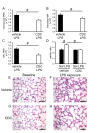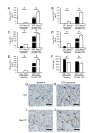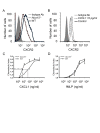Eliminating or blocking 12/15-lipoxygenase reduces neutrophil recruitment in mouse models of acute lung injury
- PMID: 22973824
- PMCID: PMC3682261
- DOI: 10.1186/cc11518
Eliminating or blocking 12/15-lipoxygenase reduces neutrophil recruitment in mouse models of acute lung injury
Abstract
Introduction: Acute lung injury (ALI) is a common disease in critically ill patients with a high morbidity and mortality. 12/15-lipoxygenase (12/15-LO) is an enzyme generating 12-hydroxy-eicosatetraenoic acid (12-HETE) and 15-HETE from arachidonic acid. It has been shown that 12/15-LO is involved in the regulation of vascular permeability during ALI.
Methods: To test whether 12/15-LO participates in leukocyte recruitment into the lung, we investigated the role of 12/15-LO in mouse models of lipopolysaccharide (LPS)-induced pulmonary inflammation and acid-induced ALI, a clinically relevant model of acute lung injury.
Results: The increase in neutrophil recruitment following LPS inhalation was reduced in 12/15-LO-deficient (Alox15(-/-)) mice and in wild-type (WT) mice after the blocking of 12/15-LO with a pharmacological inhibitor. Bone marrow chimeras revealed that 12/15-LO in hematopoietic cells regulates neutrophil accumulation in the interstitial and alveolar compartments, whereas the accumulation of neutrophils in the intravascular compartment is regulated by 12/15-LO in non-hematopoietic and hematopoietic cells. Mechanistically, the increased plasma levels of the chemokine CXCL1 in Alox15(-/-) mice led to a reduced response of the neutrophil chemokine receptor CXCR2 to stimulation with CXCL1, which in turn abrogated neutrophil recruitment. Alox15(-/-) mice also showed decreased edema formation, reduced neutrophil recruitment and improved gas exchange in an acid-induced ALI model.
Conclusions: Our findings suggest that 12/15-LO modulates neutrophil recruitment into the lung by regulating chemokine/chemokine receptor homeostasis.
Figures







Comment in
-
A lipid mediator controls neutrophil recruitment in acute lung injury--should we really be surprised?Crit Care. 2012 Oct 25;16(5):161. doi: 10.1186/cc11519. Crit Care. 2012. PMID: 23102473 Free PMC article.
Similar articles
-
A lipid mediator controls neutrophil recruitment in acute lung injury--should we really be surprised?Crit Care. 2012 Oct 25;16(5):161. doi: 10.1186/cc11519. Crit Care. 2012. PMID: 23102473 Free PMC article.
-
Improved survival and reduced vascular permeability by eliminating or blocking 12/15-lipoxygenase in mouse models of acute lung injury (ALI).J Immunol. 2009 Oct 1;183(7):4715-22. doi: 10.4049/jimmunol.0802592. Epub 2009 Sep 14. J Immunol. 2009. PMID: 19752233 Free PMC article.
-
Therapeutic inhibition of CXCR2 by Reparixin attenuates acute lung injury in mice.Br J Pharmacol. 2008 Oct;155(3):357-64. doi: 10.1038/bjp.2008.270. Epub 2008 Jun 30. Br J Pharmacol. 2008. PMID: 18587419 Free PMC article.
-
15-Lipoxygenase worsens renal fibrosis, inflammation, and metabolism in a murine model of ureteral obstruction.Am J Physiol Renal Physiol. 2022 Jan 1;322(1):F105-F119. doi: 10.1152/ajprenal.00214.2021. Epub 2021 Dec 6. Am J Physiol Renal Physiol. 2022. PMID: 34866403 Free PMC article.
-
On the biosynthesis and biological role of eoxins and 15-lipoxygenase-1 in airway inflammation and Hodgkin lymphoma.Prostaglandins Other Lipid Mediat. 2009 Sep;89(3-4):120-5. doi: 10.1016/j.prostaglandins.2008.12.003. Epub 2008 Dec 14. Prostaglandins Other Lipid Mediat. 2009. PMID: 19130894 Review.
Cited by
-
A lipid mediator controls neutrophil recruitment in acute lung injury--should we really be surprised?Crit Care. 2012 Oct 25;16(5):161. doi: 10.1186/cc11519. Crit Care. 2012. PMID: 23102473 Free PMC article.
-
Opposite effects of gene deficiency and pharmacological inhibition of soluble epoxide hydrolase on cardiac fibrosis.PLoS One. 2014 Apr 9;9(4):e94092. doi: 10.1371/journal.pone.0094092. eCollection 2014. PLoS One. 2014. PMID: 24718617 Free PMC article.
-
Inhibition of 12/15-Lipoxygenase Reduces Renal Inflammation and Injury in Streptozotocin-Induced Diabetic Mice.J Diabetes Metab. 2015 Jun;6(6):555. doi: 10.4172/2155-6156.1000555. Epub 2015 May 30. J Diabetes Metab. 2015. PMID: 26823989 Free PMC article.
-
Protein and vitamin B6 intake are associated with liver steatosis assessed by transient elastography, especially in obese individuals.Clin Mol Hepatol. 2017 Sep;23(3):249-259. doi: 10.3350/cmh.2017.0019. Epub 2017 Jul 28. Clin Mol Hepatol. 2017. PMID: 28750503 Free PMC article.
-
The profile of oxidative stress markers (arachidonic and linoleic acid derivatives) in patients with benign prostatic hyperplasia in relation to metabolic syndrome.Aging (Albany NY). 2025 Jan 6;17(1):116-130. doi: 10.18632/aging.206187. Epub 2025 Jan 6. Aging (Albany NY). 2025. PMID: 39773533 Free PMC article.
References
-
- Doerschuk CM. Mechanisms of leukocyte sequestration in inflamed lungs. Microcirculation. 2001;16:71–88. - PubMed
Publication types
MeSH terms
Substances
LinkOut - more resources
Full Text Sources
Other Literature Sources
Molecular Biology Databases

